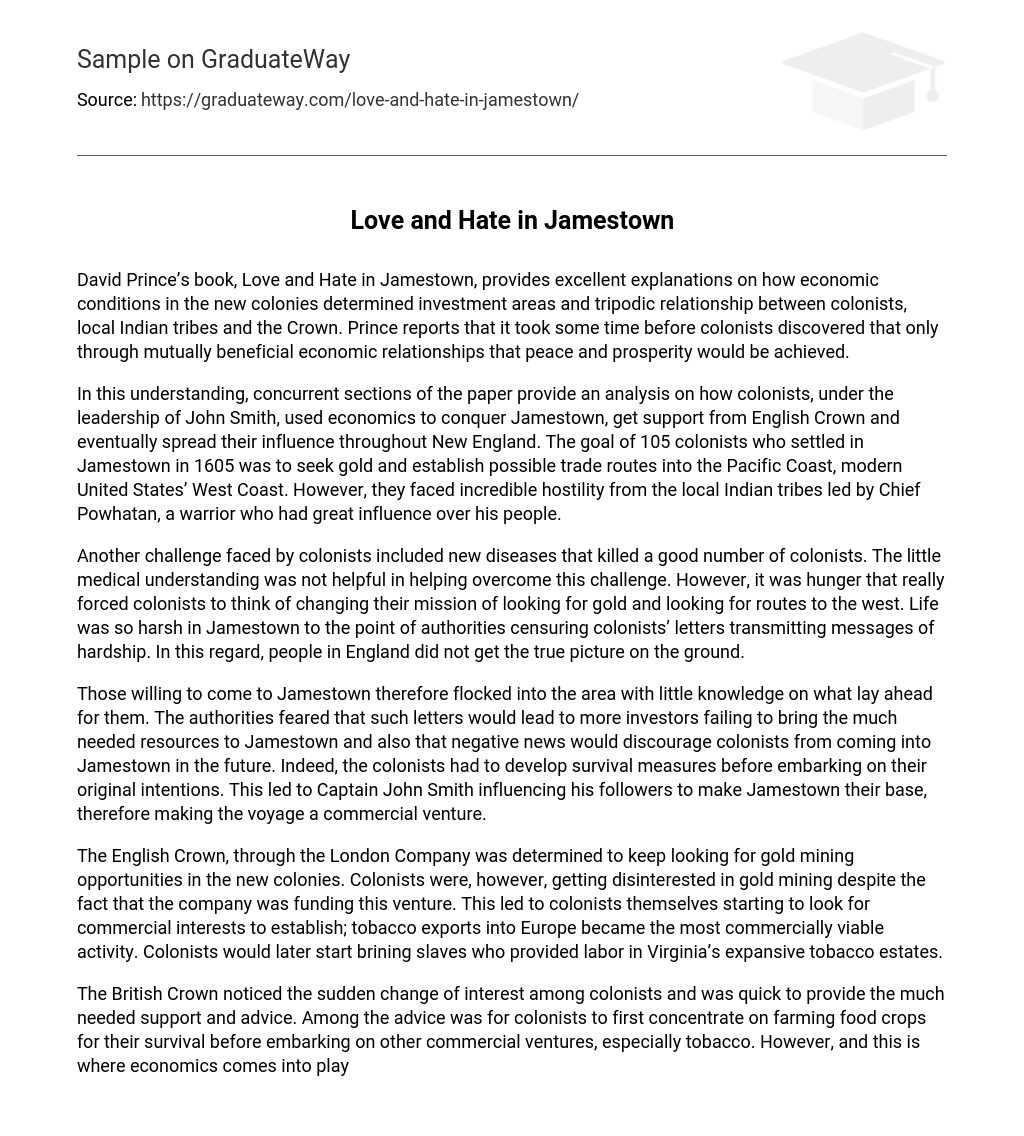David Prince’s book, Love and Hate in Jamestown, offers insightful insights into the role of economic conditions in new colonies. It explores the interdependent relationship between colonists, local Indian tribes, and the Crown, emphasizing how these conditions influenced investment areas. According to Prince, it was a gradual realization for colonists that they needed mutually beneficial economic relationships to attain both peace and prosperity.
In this analysis, the paper explores how economics played a crucial role in the colonization of Jamestown by John Smith, as well as in gaining support from the English Crown and expanding influence in New England. The initial objective of the 105 colonists who arrived in Jamestown in 1605 was to find gold and establish potential trade routes along the Pacific Coast, which is now the modern West Coast of the United States. Nonetheless, they encountered considerable hostility from local Indian tribes, particularly Chief Powhatan who held significant sway over his people.
One of the challenges encountered by colonists was the prevalence of new diseases that proved fatal for many. Limited medical knowledge hindered their ability to overcome this obstacle. However, it was the relentless hunger that ultimately compelled the colonists to reconsider their primary goal of seeking gold and exploring routes to the west. Life in Jamestown was exceedingly harsh, with authorities even censoring colonists’ letters that conveyed messages of hardship. Consequently, people in England were unaware of the true extent of the difficulties faced by the colonists.
Those who were willing to come to Jamestown arrived without much information about what awaited them. The authorities were worried that letters like these would discourage potential investors from providing the necessary resources and deter future colonists from coming to Jamestown. As a result, the colonists had to focus on finding ways to survive before pursuing their initial goals. This prompted Captain John Smith to convince his followers to establish Jamestown as their base, turning the journey into a business opportunity.
The English Crown, through the London Company, was relentless in its search for gold mining opportunities in the new colonies. However, despite the company’s financial backing, colonists grew uninterested in this venture. As a result, they began pursuing commercial interests of their own, with tobacco exports to Europe proving to be the most profitable. Eventually, colonists introduced slaves to provide labor in Virginia’s vast tobacco estates.
The British Crown promptly recognized the shift in interest among colonists and swiftly offered essential support and guidance. One of their recommendations was for colonists to prioritize cultivating food crops for sustenance before engaging in other business endeavors, particularly the cultivation of tobacco. Nevertheless, economics played a crucial role in this situation as the indigenous population excelled in corn farming. Consequently, the colonists would export their tobacco and utilize the earnings to procure locally grown corn.
The trade between the colonists and the Indian tribes was a double-success. It provided food for the colonists while also fostering friendship with the Indians. Captain John Smith recognized the importance of maintaining constant interaction with the Indians to achieve peaceful coexistence. However, Chief Powhatan and his people harbored a great deal of distrust towards the cunning colonists who were encroaching on their territory. To reduce this distrust, Smith advocated for continued trading with the Indians, which appealed to Chief Powhatan and his people. Additionally, Smith formed a mutual friendship with Pocahontas, the daughter of Chief Powhatan.
According to Price (243), Smith underwent a unique and rigorous adoption procedure that no other outsider had experienced before him. Additionally, Pocahontas later rescued Smith from her people on two separate occasions. Although historical records suggest that Pocahontas had a romantic relationship with Captain Smith, she eventually married a colonist, which further strengthened the bond between the two warring groups. This demonstrated the colonists’ commitment to becoming part of the local community through trade and social interactions. Captain Smith believed that this increased interaction was beneficial for business and would provide a long-term solution to hostilities.
Most colonists did not accept native people as equals, making him a loner in this belief. Chief Powhatan, however, understood this and kept his warriors prepared to attack when relations soured. The colonists, on the other hand, were oblivious and failed to defend themselves adequately, resulting in a massacre that claimed over 500 lives. The importance of Captain John Smith in holding the Jamestown community together became evident when chaos ensued during his absence in England for medical reasons.
The naive colonists began to clash with Chief Powhatan and his people, causing the corn trade to collapse and resulting in the starving time for the colonists even though they had enough resources to purchase food. The treacherous Indians then massacred the colonists due to their lack of wisdom and bravery to retaliate (Price 214). However, despite these difficulties, the colonists had encroached so much on the territory of the native people that attempts to eliminate or instill fear could not halt the population increase, which had already surpassed 8,000.
Moreover, with the backing of the British Crown, colonists held significant economic power over indigenous people. Their ability to navigate economic challenges greatly contributed to their survival. The author of this book skillfully highlights this aspect, elevating the Jamestown narrative to one of the most remarkable tales of survival in American history. Hence, this book proves valuable not only for history classes but also for those interested in economics and American history as a whole.





